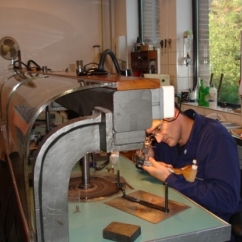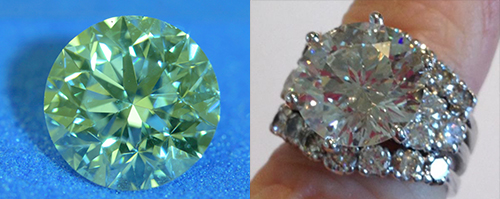Articles and News
The Case For Buying Diamonds Off The Street And Recutting Them | April 30, 2014 (2 comments)

San Diego, CA—A service once the domain of pawnshops, many guild and luxury jewelers also buy gold, diamonds and jewelry items from their customers and the public. A recent seminar at the 2014 American Gem Society Conclave in San Diego, CA, explored the topic of buying off the street (OTS), focusing on buying, re-cutting and selling OTS diamonds. Moderated by Evert Botha, RS, COO of Canadian diamond cutting Embee Diamond, the session and follow-up conversations offered insights into this part of a jeweler's business.
While many jewelers are comfortable buying diamonds OTS, many are just getting started in this arena. Jewelers Marc Altman, CGA, B&E Jewelers, Southampton, PA, and Laura Stanley, CGA, Stanley Jewelers Gemologists, North Little Rock, AR, are two that feel the OTS buying is a service to their customers. And it's one that they offer now on a daily basis where even a low offer is a better offer than their customers receive from most pawnshops. "We see customers taking next to nothing for their jewelry out there," says Altman.



From left, Evert Botha, Embee Diamonds; Laura Stanley, Stanley Jewelers Gemologist; Marc Altman, B&E Jewelers.
Stanley agrees. Her experience began with an estate and consignment department, which is quite different than purchasing from customers. But in the last few years, buying from customers has become routine. "It was a little awkward at first to offer customers money for jewelry," says Stanley. "But we eventually realized that that our worst offer is actually so much better than anyone else's."
Offers are generally low due to the excess goods available for purchase OTS. Clearly these jewelers and jewelers around the country have found a price point that works for both parties—the customer gets cash for jewelry they don’t want, and jewelers have a source of supply that can provide a high margin on resale. Indeed, the street has become an integral part of the diamond supply chain for American independent jewelers.
How much does a customer need to know about previously owned jewelry? Attendees at the session generally agreed they were comfortable disclosing the fact that the piece or stone was pre-owned, but one jeweler did warn that some customers might be reluctant to buy a diamond from a failed marriage or someone who died recently. (Editor's note: According to the Federal Trade Commission, something that's unused, unaltered, and returned according to the retailers' stated policy may be sold as new, but anything that has been rebuilt, remanufactured, reconditioned--or recut--isn't new.)
One by-product of buying diamonds OTS is a large inventory of well-priced goods. But often those goods are not ready for resale to the public. Some of these goods simply get resold to dealers and companies who re-cut and resell large batches of stones. But in smaller batches or one-by-one, that's easy for jewelers to do on their own—although re-cutting diamonds is not second nature to most jewelers.
Altman elaborates. "For the 20 years that I have been a gemologist, I have had the practical experience of ordering the re-cutting or repairing of only six diamonds, until four years ago. But since 2009, I have ordered the re-cutting of significantly more than 1,000 diamonds."
Since Altman began re-cutting, the calculations required have become second nature to him. "Although gemologists are trained to calculate the approximate re-cut weight for repairs and/or for a full re-cut, most do not have the practical experience. And that is a business and service that is profitable. Jewelers should revisit re-cutting as an offering to their clients as well as for the re-cutting of the diamonds purchased off the street."
So how do you know when a diamond needs to be recut? According to Botha, some stones just need a little attention; others need a lot. "We look at them and see which category they fall in: repair, re-polish or re-cut. Sometimes, a bit of repair or re-polishing will restore them. Repairs include chips, breaks, and small fractures. Other times re-cutting is the way to go," says Botha.
Botha sees a great number of stones each year. Often it's a customer's stone that is sent in, but he sees plenty of regular and OTS inventory that needs attention as well. He offers some guidelines for inventory evaluation. "If it's sitting in inventory or keeps coming back; If it lacks brilliance, looks dull; or if it is a low cut grade, it needs to be re-cut. A re-cut diamond is fresh inventory and in most instances will increase in value. You're not recycling metal, you're increasing the appeal and value of your inventory."
A case in point: Stanley's bought an estate that contained a large (8.177-ct.) diamond. It eventually sold, only to be returned a month later. "The problem was that its main feature was its size. But it wasn't a great diamond, just a big one. When it came back we knew we needed to do something,” says Stanley. Looking for a new identity for the big stone, she sent it to Botha for a consultation. He suggested re-cutting it into a Sirius Star 100 and she agreed. It was re-cut to 7.311 cts.

An 8.177-ct diamond from Stanley's was impressively large, but not very pretty (left). After recutting, the finished stone emerged 86 points smaller, but much more attractive (right). It sold quickly and for more money than when it was bigger.
Although it lost more than three-quarters of a carat, it became a bright, beautiful, highly desirable stone. The stone sold quickly after, for substantially more than it did initially. "After re-cutting it was an easy sale," said Stanley. "We recouped our investment many times over, sold a beautiful diamond, and our customer is thrilled."
Top image: Panoramio.com







